'The summer of 1857 saw violence, perpetrated by the Indians and the Britons, on an unprecedented scale.'
'Never before and never after in the history of British rule in India was there violence at the level that 1857 witnessed.'
Historian Rudrangshu Mukherjee revisits a chapter of history that is often ignored.
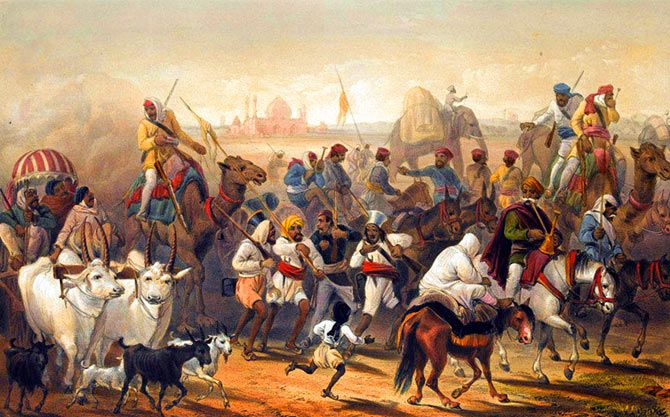
Photograph: Kind courtesy National Army Museum/Wikimedia Commons.
Anniversaries are important in India. Thus, it will surprise nobody if the 160th anniversary of the revolt of 1857 is celebrated with some fanfare.
Speeches will be made extolling the revolt as the First War of Indian Independence, as Vinayak Damodar Savarkar called it.
Such celebrations invariably have a propensity to underplay a very integral element of the rebellion: Violence.
The summer of 1857 saw violence, perpetrated by the Indians and the Britons, on an unprecedented scale.
Never before and never after in the history of British rule in India was there violence at the level that 1857 witnessed.
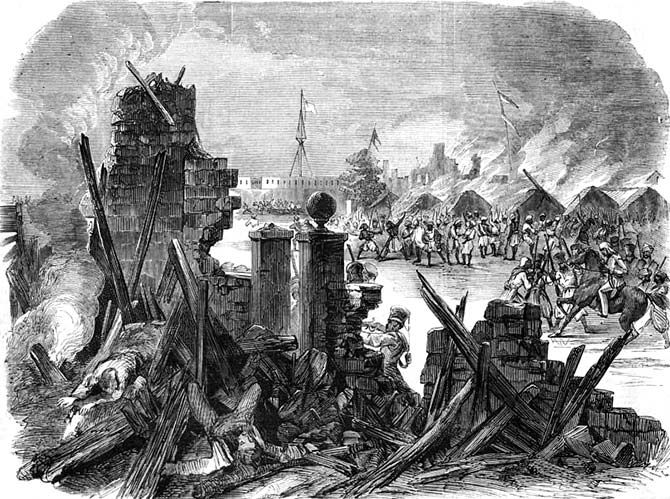
The mutiny began with the destruction of government buildings in Meerut on May 10.
Photograph: Kind courtesy Wikimedia Commons
It began with violence in the late afternoon of May 10 in Meerut with the sepoys destroying government buildings -- the jail, record room, kachehri, telegraph office -- and going on to destroy the bungalows in which the firangi lived.
The peasants of the surrounding villages participated in the destruction. What accompanied the destruction was the killing of the White population of Meerut, irrespective of gender and age.
Once the mayhem was over and dusk had fallen, a group of sepoys rode off towards Delhi where they arrived in the morning of May 11.
It was the month of Ramadan and the old and powerless Mughal Emperor, Bahadur Shah, heard a clamour outside his window in the Lal Qilla. The sepoys from Meerut were the source of the commotion.
They declared to their Badshah that they had killed the firangi and had declared war on them in Meerut. They had come to him to make him their leader.
Another group of sepoys had already entered Delhi and there, together with the sepoys stationed in Delhi, they destroyed and killed, their targets being government property and the White people.
A handful of Britons escaped to take refuge in Metcalfe House.
Ghalib who saw the scenes of destruction noted thus in his diary: 'Throughout the day, the rebels looted the city, and at night they slept in silken beds...The city of Delhi was emptied of its rulers and peopled instead by creatures of the Lord who accepted no lord...'
By May 12, Delhi was outside British control and Bahadur Shah had been forced by the sepoys to become the leader of the rebellion.
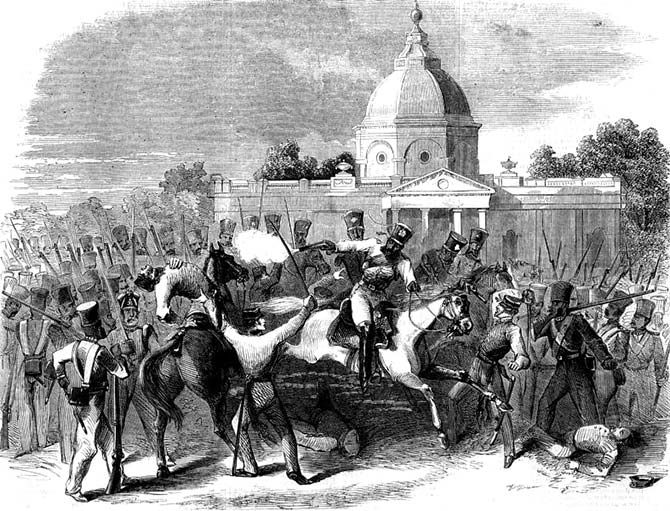
Photograph: Kind courtesy Wikimedia Commons
As the news of the fall of Delhi travelled down the Ganges valley, cantonment after cantonment mutinied till, by the beginning of June, British rule in North India, save in Punjab and Bengal, had disappeared.
It had 'collapsed', in the words of one British officer, 'like a house made of cards'.
In every cantonment, the mutinies followed the pattern set in Meerut.
The sepoys destroyed government property and killed. They were joined in this violence by the villagers of the surrounding area. The sepoys, who were all of rural origin and were therefore peasants in uniform, once they had mutinied, shed their uniforms and easily merged with the rural folks.
An emeute in the army thus quickly acquired the character of a popular uprising by moving beyond the barracks.
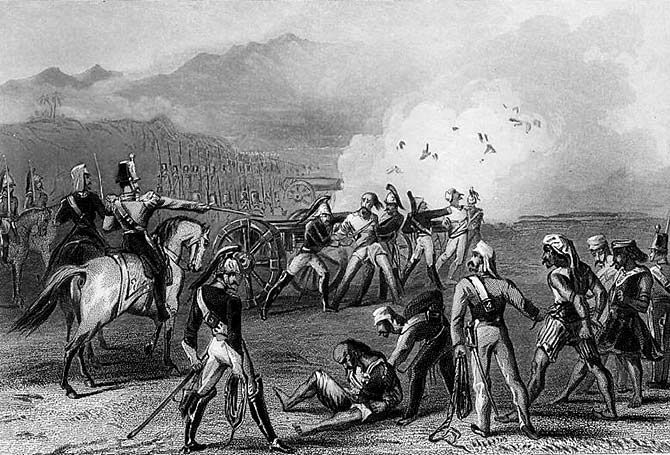
By the beginning of June 1857, the Delhi, Meerut, Rohilkhand, Agra, Allahabad and Benares divisions had been placed under martial law.
The British confronted the brutal rebellion with brutal tyranny.
Photograph: Kind courtesy Wikimedia Commons
British measures to put an end to this rebellion were not slow in coming.
And these measures displayed unparalleled ferocity and vengeance.
By the beginning of June 1857, the Delhi, Meerut, Rohilkhand, Agra, Allahabad and Benares divisions had been placed under martial law.
By a series of Acts passed in May and June, the definition of martial law was enlarged. These various Acts gave Britons the power to judge and take the life of Indians without recourse to the due process of law.
All restrictions on the use of power were removed.
One officer wrote to The Times: 'We have the power of life and death in our hands; and I assure you we spare not. A very summary trial is all that takes place.'
British rule in North India had come perilously close to being destroyed and the British had no other instrument at their command except the deployment of terror on a grand scale to restore their dominance.
Imperial rule could only be maintained and reproduced by a show of terror and force: The fiction of civilising the Indians dissolved in the reality of the violence.
Any form of rebellion, from stealing to desertion and possessing money that could not be accounted for, was punished by death.
Colonel James Neill, who was one of the commanding officers of the troops that moved up the Gangetic plain to quell the uprising, gave the following orders to 'settle' the town and the country around Allahabad: 'All the men inhabiting them (certain named villages) were to be slaughtered.'
'All sepoys of mutinous regiments not giving a good account of themselves were to be hanged.'
'The town of Futtehpore, which had revolted, was to be attacked, and the Pathan quarters destroyed with all their inhabitants. All heads of insurgents, particularly at Futtehpore, to be hanged.'
'If the Deputy Collector is taken, hang him and have his head cut off and stuck up on one the principal (Mahomedan) buildings of the town.'
William Howard Russell, the correspondent of the London Times, who was in India in 1858, met an officer who was a part of the column that under Neill's orders marched from Allahabad to Kanpur.
The officer reported that 'in two days, 42 men were hanged on the roadside, and a batch of 12 men was executed because their faces were turned the wrong way when they were met on the march.'
Even boys who had playfully flaunted rebel colours and beaten a tom-tom were not spared.
Every Indian who appeared in sight was shot or hung on the trees that lined the road; villages were burnt.
Tyranny thus confronted rebellion.
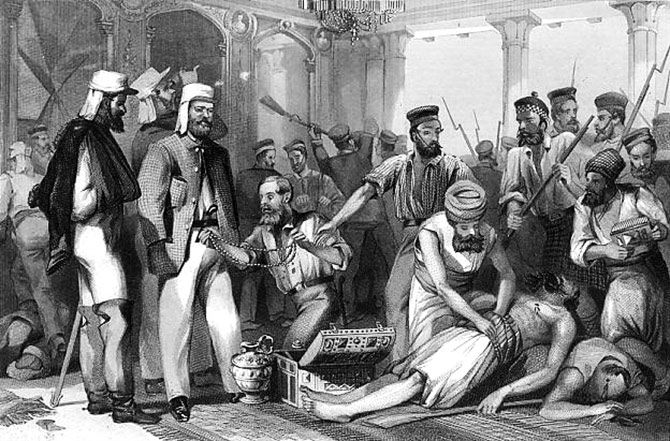
The steel engraving depicts a London Times correspondent looking on.
Photograph: Kind courtesy Wikimedia Commons
The government was unofficially warned about the policy of burning villages: It would make cultivation impossible, a famine inevitable and land revenue scarce. But there was a purpose in these acts of arson.
A village is an integral part of a peasant's self-identity, his sense of belonging, a place where he is not a stranger. It is thus the primary location of a shared solidarity.
The burning of the villages -- homesteads, human shelters, barns, crops and so on -- was aimed to interrupt the solidarity and cycle of agriculture that was the pivot of that form of life.
A village is also the site of stories, myths and histories; by burning it, the British sought to obliterate the memory of a culture.
Reflecting on these counter-insurgency measures, J W Kaye, who in the late 1860s and 1870s penned a magisterial history of what he called the 'sepoy war' -- and he was not known to be sympathetic to the rebels -- wrote: 'Over the whole of the Sepoy War there is no darker cloud than that which gathered over Allahabad in this terrible summer... It is on the records of our British Parliament, in papers sent home by the Governor-General of India in Council, that the 'aged, women and children are sacrificed as well as those guilty of rebellion'. They were not deliberately hanged, but burnt to death in their villages..."
'Englishmen did not hesitate to boast, or to record their boastings in writing, that they had 'spared no one' and that 'peppering away at niggers' was very pleasant pastime.'
It was not as if the violence was carried out by men who were 'out there,' but it was known to the highest authorities and had their consent.

Photograph: Felice A Beato/Getty Images
Violence in 1857 acquired a different level of intensity by what happened in Kanpur in the end of June and then again at the end of July.
The mutiny began in Kanpur on June 4. But since the outbreak at Meerut, the commander of the Kanpur division, Hugh Wheeler, had made preparations for the safety of the Europeans. He had fortified and stocked with food a set of barracks and here he moved the 900 Europeans of Kanpur.
The fortified area came to be known as the 'entrenchment'.
Here the British remained from June 4 to June 27 surrounded on all sides by the rebels and fired upon night and day. But the British withstood the siege and this became a chapter in the history of British heroism and suffering.
On June 25, the British pickets through an intermediary received an offer of safe passage to Allahabad by river on boats and the men to be allowed 60 rounds of ammunition each.
On the morning of June 27, around 450 Britons came out of the entrenchment to proceed to Satichaura Ghat where the boats were kept.
As the British had nearly finished boarding the boats, the boatmen set fire to the thatched awnings of the boats and guns opened fire from both the banks of the Ganges; and finally the cavalry went in to slash and kill those who had survived the shooting.
All but 130 were slaughtered; 20 of the survivors managed to escape and the rest were taken prisoner.
It would appear from all available evidence that the massacre at Satichaura Ghat had been planned in advance: The guns and troops were strategically placed, the rebels took up their positions at night, and orders were given to the neighbouring villagers to be present at the ghat.
And they were present, according to one witness, "with swords, spears and battle axes".
The two boats that got away were chased and shot down. The boatmen set fire to the thatched awnings at a signal and the guns opened fire at the sound of a bugle. The cavalry went into the water to slash the survivors on very definite orders from Tantia Tope and the operations were supervised by Teeka Singh, Jwala Prasad (a close associate of Nana Sahib), a cavalry trooper called Nukkee and Tope all of whom sat on a specially erected platform.
The massacre took the nature of an execution: An open and public affair watched by 10,000 to 12,000 people. It was an expression of the collective hatred of the firangi.
The massacre at Satichaura Ghat came close on the heels of Neill's counter-insurgency measures. It is not unfair to conjecture that the news of British atrocities had reached the rebels in Kanpur and the massacre was their revenge for it.
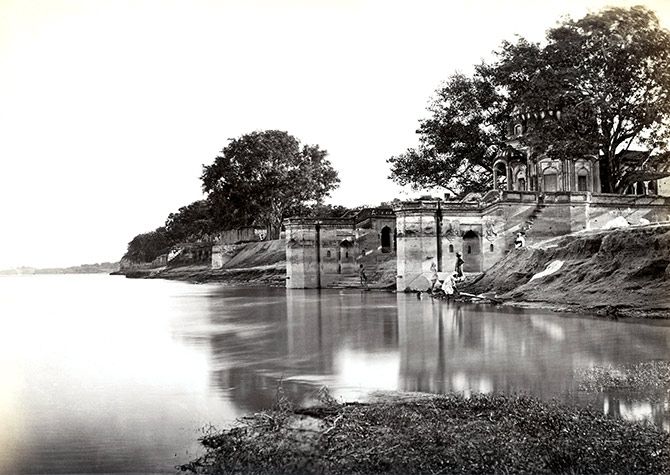
Photograph: Samuel Bourne/Hulton Archive/Getty Images
The narrative of the violence in Kanpur does not end here.
The male survivors from Satichaura Ghat were all shot. The women and children were kept as prisoners in a room known as Bibighur.
When the news reached Kanpur that the British forces were very close to entering the town, orders were given on July 15 to kill the prisoners in Bibighur.
Four or five professional butchers were sent in, after the sepoys had refused to kill them, and they cut up the prisoners with swords and long knives.
The bodies -- it was said that not all of them were dead -- were thrown into a well.
When the British troops under Neill's command entered Kanpur, they pieced together what had happened at Satichaura Ghat and Bibighur. They were all driven by the 'fierce thirst for revenge'.
Neill spelt out what he wanted to achieve: 'My object is to inflict a fearful punishment for a revolting, cowardly, barbarous deed and to strike terror into these rebels.'
Neill went on to describe the method through which to instil terror: 'Whenever a rebel is caught, he is immediately tried and unless he can prove a defence he is sentenced to be hanged at once; but the chief rebels or ringleaders I first make clean up a portion of the pool of blood.'
'To touch blood is most abhorrent to the high caste natives; they think by doing so they doom their souls to perdition. Let them think so.'
Neill went a step further after the 'accused' had been hung -- he instructed that 'all the Brahmins will be buried and all the Mahomedans burned.'
Punishment followed in the after-life.
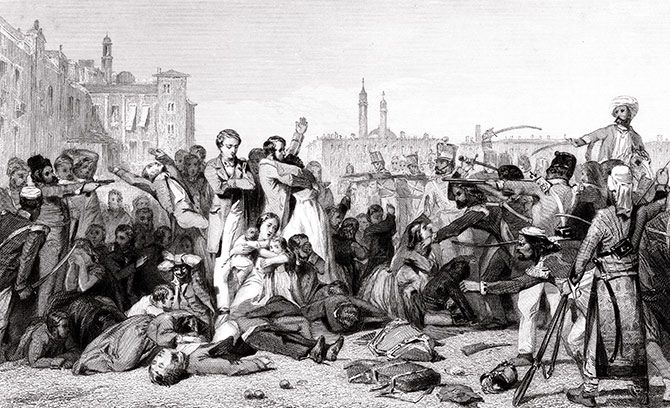
As the British troops drew closer, professional butchers were sent in to kill them.
Photograph: Hulton Archive/Getty Images
As it always is with victors, the British believed they had been the victims and they had been on the side of angels.
Thus, they commemorated the well near Bibighur as a shrine.
A weeping angel carved in marble by Marochetti was placed over the well and on the stone was the simple epitaph: 'These are they who have come out of great tribulation.'
The shrine was made into the exclusive preserve of the White man. No Indians, except Christians, were allowed near the well till August 15, 1947.
On that day, the crowd rushed in and popular enthusiasm could not be contained; the crowd damaged the nose of the angel.
Following this, the decision was taken to remove the angel and the memorial and to re-erect in the memorial church in Wheeler's entrenchment by the cantonment.
A bronze statue of Tantia Tope was erected overlooking the well. Only with this reversal of icons could it be said that the cycle of violence that was initiated on May 10, 1857 had come to a closure.
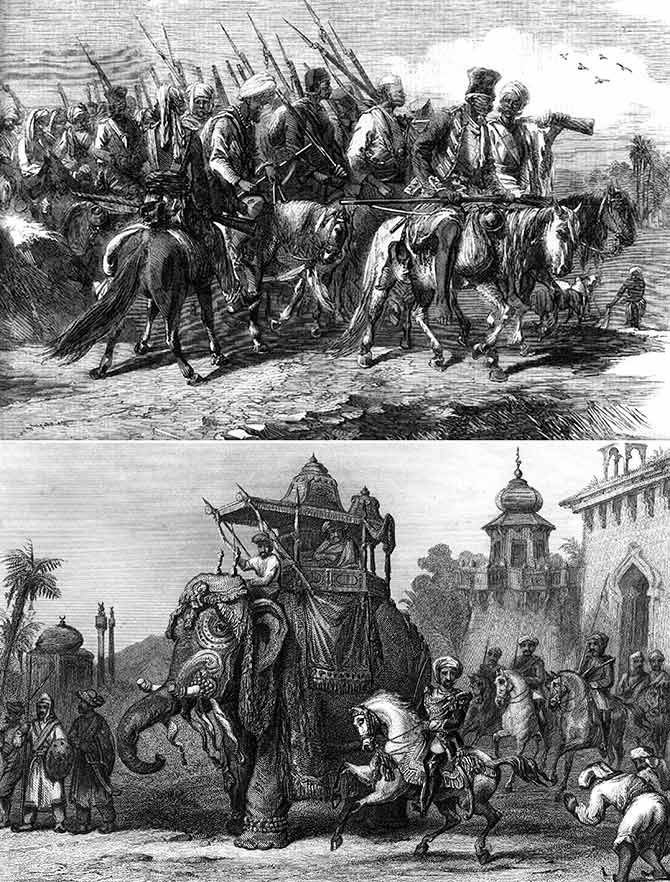
Photograph: Kind courtesy Wikimedia Commons and Hulton Archive/Getty Images
The closure is so final and the replacement of British heroes by Indian 'freedom fighters' is so complete that when anniversaries of 1857 are observed, a curtain is drawn upon the massacres in Kanpur carried out by the rebels.
Nowhere is this more evident than in Jawaharlal Nehru's The Discovery of India where he had this single sentence on rebel violence: 'The rebel Indians sometimes indulged in cruel and barbarous behaviour; they were... often angered by reports of British excesses.'
The use of the word 'sometimes' is telling.
In the centenary year, the Government of India produced a volume on 1857 written by the famous historian S N Sen. The project had been sponsored by the then education minister, Abul Kalam Azad, who had advised Sen to produce an 'objective' history of the uprising.
Sen had very little to say about rebel violence and tried to free Nana Sahib from any responsibility for the massacre which he said was the work of the sepoys.
A freedom fighter like Nana Sahib with his assigned place in India's Book of Martyrs could hardly have his hand tainted by blood.
There remains a persistent refusal to recognise rebel violence and its spectacular scale as displayed in the massacres in Kanpur.
In the absence of that recognition, any attempt to observe the anniversary will be incomplete and all attempts to appropriate the uprising into the annals of the Indian national struggle will be fraught with tension.
There is one other aspect that needs to be borne in mind in the present conjuncture. This relates to the ethical issues relating to violence.
In a world living under the shadow of terrorist violence and the violence concentrated in the hands of some nations, principally the United States, it is worth reflecting on the use of violence and its celebration as a part of a nation's struggle for freedom.
Mahatma Gandhi's message of non-violence may not be as irrelevant as is often made out to be in the pursuit to be a great power.











